 The 'sticky' Casimir force can even be repulsive.Jay Penni and Federico Capasso
The 'sticky' Casimir force can even be repulsive.Jay Penni and Federico CapassoPosted on 03/28/2009 12:08:25 AM PDT by neverdem
The quantum stickiness between very close surfaces produces no drag when they move, researchers claim.
 The 'sticky' Casimir force can even be repulsive.Jay Penni and Federico Capasso
The 'sticky' Casimir force can even be repulsive.Jay Penni and Federico CapassoThe quantum-mechanical effect that makes objects stick together when they are very close produces no friction when the objects are moving, two physicists claim. The results suggest that the operation of nanoscale machinery might not be as sticky a problem as feared.
It's long been thought that the 'Casimir force', which pulls together two objects when they are much less than a hair's breadth apart, will create a drag force when the objects move. "We expected to find a lateral [frictional] force", admits physicist Tom Philbin of St Andrews University in the United Kingdom, who performed the calculations with colleague Ulf Leonhardt. But the two researchers now think that previous studies were wrong.
If they are right, it means that, while the Casimir force may cause 'stiction' in nanomachines – moving parts might stick together – it needn't cause friction. The Casimir force only acts perpendicular to the two surfaces in near contact, while friction acts parallel to the surfaces.
The Casimir force is generally felt only when two surfaces are closer than a few tens of nanometres. The existence of short-range forces between molecular-scale bodies was first postulated in the nineteenth century, but in the 1940s, Dutch scientist Hendrik Casimir and his collaborators made the first detailed measurements of how the force depends on the separation of the objects.
Casimir and his colleagues explained how the attractive force arises from fluctuations of electric charge in the surfaces, caused by quantum effects. Another, equivalent way of describing the Casimir force is as a property of empty space itself: subatomic particles that pop in and out of existence in a vacuum between the two surfaces affect the way they interact.
This picture was clarified by the Soviet physicist Evgeny Lifshitz in the 1950s, and the force is now sometimes called the Casimir-Lifshitz force. But extending Lifshitz's theory to the case where the surfaces are moving relative to one another turns out to be surprisingly hard.
Almost all such calculations so far have indicated that the force will create lateral friction. In this view, the quantum vacuum acts like a kind of fluid with a viscosity that imposes a drag on the moving objects. But these earlier studies have differed in their estimates of how big this drag will be.
Philbin and Leonhardt began their own calculations on the assumption that such a drag exists. They wanted to explore the possibility that the friction force could be modified by changing the nature of the interacting surfaces. It has been long suspected, and recently confirmed1, that with a careful choice of materials the Casimir force can even be repulsive.
Yet to their surprise, the researchers found that, when two parallel plates move past one another at constant relative speed, the plates experience no quantum friction at all. Their results are to be published shortly in the New Journal of Physics2.
But not everyone is convinced by the new work. Physicist John Pendry of Imperial College in London, who previously calculated that the Casimir force should give rise to a frictional effect, stands by that earlier conclusion.
The attractive force between surfaces arises because quantum fluctuations of electric charge in one of them induce 'mirror image' charges in the other. But if the surfaces are moving, says Pendry, "there is a slight lag and the centre of gravity of the image charges is no longer directly underneath the original. This lag leads to energy dissipation through a frictional force, as if the first surface were towing the charge in the other surface behind it".
Pendry says that something equivalent to this frictional force has already been seen in experiments on electrical currents moving in two thin sheets of conductive material separated by an insulating layer.
Philbin recognizes that, given the contradiction with previous results, their claim "isn't going to be accepted overnight". But even if their calculations turn out to be right, it does not mean nanomachines, which are already being made by engineers, will feel no friction at all. Friction certainly occurs when the surfaces of these tiny mechanical devices touch each other3, as both experiments and theory have shown.
Geometer wins maths 'Nobel' - Abel prize awarded to Mikhail Leonidovich Gromov.
FReepmail me if you want on or off my health and science ping list.
The 'sticky' Casimir force can even be repulsive.Hey, there are whole websites devoted to that proposition, but they're mostly teases trying to sell pay-per-view. Thanks neverdem.

· Google ·
bump
Well that sucks. ;)
Maybe they should try some KY. ;)
Disclaimer: Opinions posted on Free Republic are those of the individual posters and do not necessarily represent the opinion of Free Republic or its management. All materials posted herein are protected by copyright law and the exemption for fair use of copyrighted works.